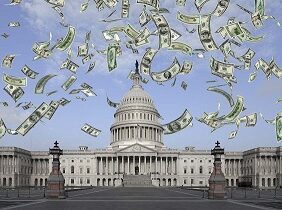Wealthy homeowners are scooping up billions of dollars in tax credits for making their residences more energy efficient, while the poor are getting almost nothing under the same Biden administration effort.
That’s according to an analysis by POLITICO’s E&E News of a tax credit program that was expanded under President Joe Biden and is designed to spur homeowners to buy solar panels, insulation materials and other items that can reduce energy bills and home emissions.
The analysis found that households with income of $200,000 or more got $2.2 billion in tax credits. Meanwhile, households with income below $25,000 got a fraction of that amount — $32 million in tax credits — even though they vastly outnumber their affluent counterparts.
The wealth disparity alarms some economists and advocates, raising concerns that the credits are giving taxpayer money to hundreds of thousands of people who don’t need financial help or incentives to buy equipment that saves them substantial money on energy bills.
“These tax credits don’t increase the affordability for families making over $500,000. They can already afford it. And they get lower energy prices,” said Mark Wolfe, executive director of the National Energy Assistance Directors Association.
Tax credits reduce dollar for dollar the income tax that individuals and households owe the federal government. The residential energy credits in 2023 cut income taxes — and federal revenue — by a total of $8.4 billion.
The average credit was $1,100, but credits were much larger for people with higher income.
The wealth disparity also intensifies questions about the Biden administration’s unprecedented use of tax incentives as a cornerstone of his climate change policy.
Brookings Institution economist Sanjay Patnaik said the growing costs of the credits and of other federal spending on climate change could turn public opinion against programs that Biden and Congress created or enlarged.
“It’s a lot of money for relatively low emissions reductions,” Patnaik, director of Brookings’ Center on Regulation and Markets, said of the energy tax credits. “It runs the risk of making climate policy less accepted by the public because people will say, This is running up a big bill and is costing much more than expected.”
The Congressional Budget Office projected in 2022 that the energy tax credits would cost $2.4 billion in 2023.
Biden has emphasized equity in his new or expanded programs to reduce carbon emissions and protect against climate impacts. His Justice40 initiative aims to provide 40 percent of benefits in some programs to communities that are “disadvantaged” by high poverty and pollution rates and low income and education levels.
The energy tax credits are not covered by Justice40.
The Treasury Department said it wants the tax credits to help middle-income families, and highlighted a statistic showing that 47 percent of the recipients in 2023 had taxable income below $100,000. U.S. median household income, which is typically higher than taxable income, was $74,600 in 2022.
“Our broad goal is to make sure that middle-class and working-class Americans throughout the country are aware of these credits,” Deputy Treasury Secretary Wally Adeyemo told reporters Aug. 7.
But Treasury’s analysis omits information showing that higher-income households dominated the energy tax credits.
People with income below $100,000 accounted for 76 percent of all federal taxpayers in 2023. Yet they received only 34 percent of the energy tax credits — $2.9 billion in total, according to an E&E News analysis that Treasury did not dispute.
People with income of $100,000 or more accounted for just 24 percent of federal taxpayers in 2023. They got 66 percent of the tax credits: $5.5 billion.
In response to E&E News’ findings, a Treasury Department spokesperson insisted that “the tax credits are largely benefitting the middle class” and said the hundreds of billions of dollars of additional Inflation Reduction Act funding is helping “left behind places.”
Patnaik of Brookings had a different perspective: “It’s basically people that are pretty wealthy are getting significantly large tax credits for making their home more energy-efficient.”
16,000 millionaires benefited last year
The energy tax credits have become increasingly prominent — and costly — since the Inflation Reduction Act of 2022 increased the amount taxpayers could receive. The law also extends the credits through 2034, the longest extension they’ve ever received.
In addition to reimbursing 18 percent of the money people spent on energy efficiency in 2023, the tax credits are helping people save tens of thousands of dollars in energy bills that will more than pay the cost of their new air conditioners, heat pumps and exterior doors.
People who got tax credits for solar panels “saved a median of $2,230 annually,” Adeyemo said. New heat pumps could save owners up to $3,100 a year.
“The savings and investments these credits spurred will go a long way in lowering and stabilizing monthly utility bills for families,” Adeyemo said.
The federal government has two comparable federal programs aimed at helping lower-income households; they offer grants and rebates for energy-efficiency improvements. The programs target people who cannot afford the equipment or who wouldn’t receive a tax credit because they take the standard IRS deduction instead of itemizing their tax credits and income deductions.
But neither program comes close to the largesse of the energy tax credits, which the Congressional Budget Office estimates will cost $34 billion through 2031.
One of those, the Weatherization Assistance Program, which launched in 1977, received a special $3.5 billion allotment through the bipartisan infrastructure law enacted in 2021 to help low-income households weatherize their homes.
By contrast, energy tax credits are more like an entitlement program — they’re given to anyone who bought an eligible item with no limit on total federal spending or on the income level of recipients.
Roughly 16,000 millionaire taxpayers received nearly $100 million in energy tax credits last year, IRS data shows.
“The reality is that higher earners are often in a better position to know about and take advantage of tax credits across the board,” said Steve Ellis, president of Taxpayers for Common Sense.
“The goal of these programs is to have more homes install solar and make their homes more energy efficient regardless of the income level of the recipient,” Ellis added.
Another related program, created through the Inflation Reduction Act, aims to give low- to moderate-income households a total of $8.5 billion in rebates for energy-efficient equipment. Yet the rebate programs must be administered by states, and only New York and Wisconsin have started.
Twenty-seven states including Florida and Texas have not applied to the Department of Energy for the money, DOE records show.
“The rebate program was designed to catch a wider swath of income levels,” David Terry, president of the National Association of State Energy Officials.
Research showing that rich people claimed an overwhelming share of federal tax credits for buying electric vehicles prompted Biden and Congress to impose income limits starting in 2023. The $7,500 credit for buying a new EV is now available only to households with income up to $300,000 and individuals with income up to $150,000.
A $4,000 credit for buying a used EV is available only for households with income up to $150,000 and individuals with income up to $75,000.
“That there are no income limits is really surprising,” Patnaik said of the energy tax credits. “This should have been capped.”
The billions of dollars in energy tax credits going to wealthy households highlights their inefficiency, according to experts who say imposing a tax on carbon emissions would be more effective and equitable.
“I understand the political advantage of subsidizes,” University of California, Berkeley, energy economist Lucas Davis said. “But in terms of changing behavior and economic efficiency, the tax approach has many advantages.”
“When you tax carbon emissions directly people look for all kinds of ways to reduce carbon emissions, not just heat pumps, not just EVs,” Davis said. “Maybe I buy a bike or move closer to work or don’t take as many airline flights.”
Some conservatives have criticized Inflation Reduction Act tax credits for helping rich people at the expense of the middle class.
Tax Foundation senior policy analyst Alex Muresianu said the E&E News analysis along with data about EV tax credits “show doing climate policy through subsidies have as many, if not more, distributional challenges as carbon pricing.”
‘Not really on the table for low-income families’
Homeowners have been receiving the energy tax credits since 2006 for installing items such as solar panels, small wind turbines, energy-efficient central air conditioning as well as insulation, windows and exterior doors that reduce energy use.
The credits saved taxpayers a total of $42 billion from 2006 through 2021, the last year for which IRS data is available, according to a July study by Davis and fellow UC Berkeley economist Severin Borenstein. That’s an average of $2.6 billion a year.
Treasury took the unusual step on Aug. 7 of releasing detailed information about the energy tax credits for the previous year before all tax returns have been filed. Treasury’s IRS typically publishes details about tax credits two or three years after it has received all returns for a tax year.
Adeyemo, the deputy treasury secretary, acknowledged that the Aug. 7 figures are “estimates” and said they “are expected to increase as more returns are filed” for the 2023 tax year.
Treasury released the incomplete tax data to tout the unexpectedly large size of the energy tax credits.
“These counts are significantly higher than in 2021,” Adeyemo said, comparing the preliminary data from 2023 to the most recent year for which full data is available. In 2021, 2.6 million households got energy tax credits compared to 3.4 million in 2023.
It’s unclear if the growth occurred because the Inflation Reduction Act made the credits more lucrative starting in 2023 or for other reasons such as a growing awareness of energy-efficiency upgrades. It’s also unclear how many people bought energy-efficiency equipment in 2023 because of the credit.
The large wealth disparity in the energy tax credit program in 2023 is “broadly consistent with the pattern from previous years,” Davis said.
But Davis said the data from 2023 is “pretty surprising” because it shows that the tax credits continue to be dominated by the rich.
“If you go back to 2006, proponents would have said in the first year or two, the credits would go to high-income households, but we expect it to broaden,” Davis said. “We’re not seeing that broadening.”
Many federal tax credits and deductions are skewed toward wealthy taxpayers because they reward costly expenses such as interest on a home mortgage that lower-income people cannot afford.
“It’s pretty well understood and much expected that the distribution of those [energy] credits would be skewed toward higher income people,” said Samantha Jacoby, deputy director of federal tax policy at the left-leaning Center on Budget and Policy Priorities.
“These upgrades have a high upfront cost,” Jacoby said. “That’s not really on the table for low-income families.”
Correction: An earlier version of this article incorrectly stated the employer of Tax Foundation senior policy analyst Alex Muresianu.
- Canva Pro











Get Social